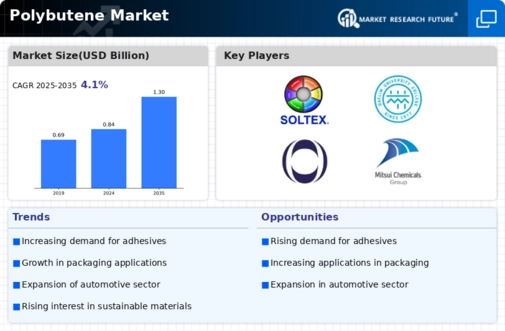Top Industry Leaders in the Polybutene Market

The polybutene (PB) market, where plastic pipes dance beneath our floors and deliver life's essentials, is a subterranean battleground where players of all sizes grapple for control. From established chemical giants to innovative niche players, the stakes are high, as these humble pipes play a crucial role in plumbing systems across the globe. Let's delve into the depths of this dynamic market, exploring the strategies, market forces, and recent developments shaping its flow.
Strategies Adopted: Building a Pipeline to Success:
-
Chemical Champions: Industry giants like Chevron Phillips Chemical Company and BASF Corporation invest heavily in R&D, developing improved PB formulations with enhanced durability, flexibility, and temperature resistance. Think next-generation PB grades for demanding industrial applications and pipes that withstand hot and cold extremes. -
Cost-Conscious Contenders: Regional players like Shanghai Chemical International and Formosa Plastics Corporation focus on affordability, utilizing efficient production processes and readily available feedstocks to cater to price-sensitive segments and emerging markets. This strategy ensures their PB pipes reach a wider audience. -
Niche Specialists: Smaller players carve out their niches by specializing in specific pipe applications or markets. Some focus on high-performance PB pipes for energy exploration and offshore installations, while others cater to the growing demand for sustainable plumbing solutions in green buildings. This targeted approach allows them to excel in specialized areas.
Factors Pumping Up the Market Demand:
-
Infrastructure Rush: Booming global infrastructure development projects, including water treatment plants, power grids, and industrial facilities, drive the need for reliable and cost-effective piping solutions like PB. -
Construction Craze: Rising urbanization and increasing construction activity across residential and commercial sectors fuel the demand for PB pipes in plumbing and heating systems. -
Regulations & Replacements: Aging infrastructure and stricter regulations on lead-based pipes create a significant market for PB as a safe and durable alternative. -
Sustainable Splash: Consumer and regulatory pressure is pushing the market towards eco-friendly solutions. This includes developing and adopting recycled PB content, minimizing waste generation, and optimizing production processes for reduced environmental impact.
Key Players:
- BASF SE (Germany)
- Dongfang Hongye Limited Company (China)
- DAELIM (South Korea)
- INEOS (UK)
- Lubrizol Corporation (U.S.)
- LyondellBasell Industries Holdings B.V. (The Netherlands)
- Mitsui Chemicals Inc. (Japan)
- TPC Group (U.S.)
- Ylem Technology Co. Ltd. (South Korea)
- Braskem (Brazil)
- KEMAT Polybutenes (Belgium)
- SOLTEX (U.S.)
- Maharasthra Polybutenes Ltd (India)
- A S Harrison & Co Pty Limited (Australia)
Recent Developments:
February 2021: It was anticipated that Celanese Corporation would finish buying Dupont's mobility and material business, which includes its polybutylene division.
July 2018: The world's largest manufacturer of polybuten-1 and a leader in research and development is LyondellBasell. THE BUSINESS HAS INTRODUCED Purell KT MR 07, the first polybutene-1 resin for healthcare applications such as IV bags and medical tubing. The company supplies different manufacturers of pipes and plumbing systems in Europe and other regions from its largest polybutene-1 production facility.
At the beginning of January 2021, Mitsui Chemicals invested substantial sums of money into setting up a research facility designed explicitly for the development of biobased polymers and advanced recycling methods. The company was demonstrating its commitment towards technological advancement as well as environmental friendliness through this move.
Despite the COVID-19 pandemic hits, LyondellBasell recorded higher volumes within its Advanced Polymer Solutions business division during October 2020 due to a recovery in automotive production. They also concluded key projects in China and the US, which allowed their polyethylene and other polymers production capabilities to be expanded.









